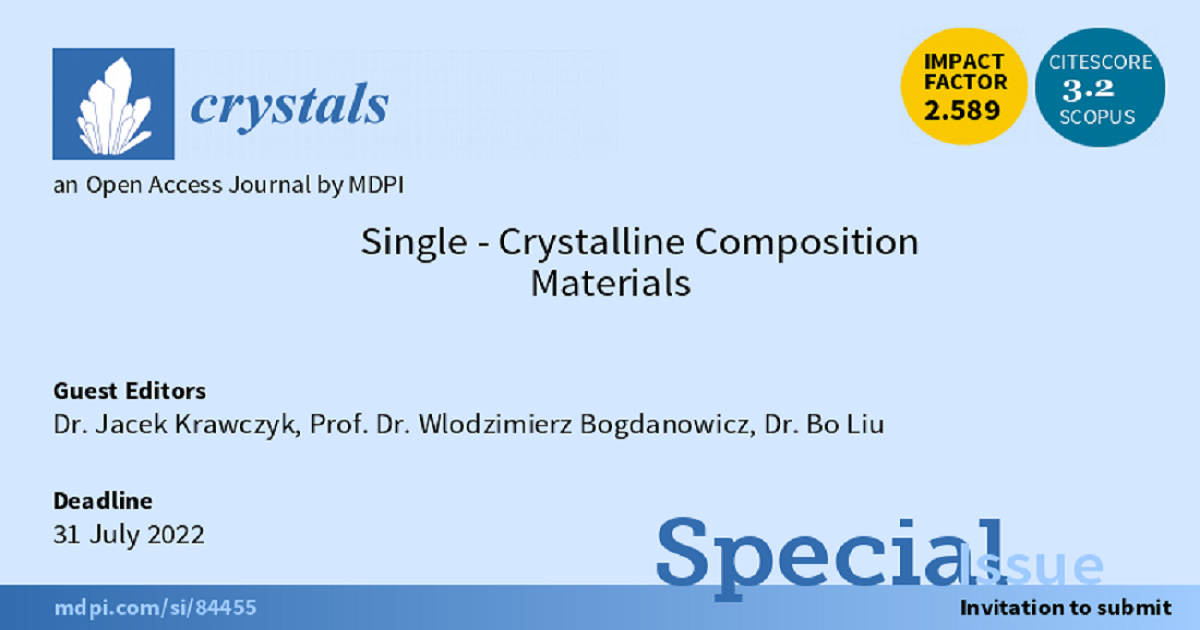Single-Crystalline Composition Materials
A special issue of Crystals (ISSN 2073-4352). This special issue belongs to the section "Hybrid and Composite Crystalline Materials".
Deadline for manuscript submissions: closed (31 July 2022) | Viewed by 8769

Special Issue Editors
Interests: superalloys; single-crystals; X-ray diffraction topography; structural defects; crystal growth
Special Issues, Collections and Topics in MDPI journals
Interests: superalloy; microstructure; mechanical property
Special Issue Information
Single-crystalline composition materials are widely used in the modern aerospace, automotive, energy, and electronic industries. Despite the often-higher costs of obtaining products made of them, they are characterized by unique properties, distinguishing them from other materials. For example, single-crystalline alloys have much better strength parameters than their polycrystalline counterparts. The properties of single-crystalline composition materials depend largely on the type and concentration of defects created in the final product. The defect structures—formed during crystallization and after potential subsequent material processing, e.g., heat treatment—can be influenced by many factors: the production technology, the geometry of the final product, the types and amounts of dopants, and others.
The above relations, combined with the need to produce single-crystalline composites with still new, different, and better properties, make it necessary to research defect structures for the development of existing crystals properties and creation of new ones, as well as for the modification of the parameters of their production. The results in this issue may create an interesting collection of papers on different aspects of production, processing, and properties of single-crystalline composition materials.
“Single-crystalline composition materials” as a Special Issue of Crystals may report novelties in the production and application of various single-crystalline composites and new methods of testing them, summarizing the progress achieved in recent years. This forthcoming Special Issue will focus on recent innovative and pioneering works in the field of single-crystalline composition materials, their production and examination, and the development of the crystallization and research methods.
Dr. Jacek Krawczyk
Prof. Dr. Wlodzimierz Bogdanowicz
Dr. Bo Liu
Guest Editors
Manuscript Submission Information
Manuscripts should be submitted online at www.mdpi.com by registering and logging in to this website. Once you are registered, click here to go to the submission form. Manuscripts can be submitted until the deadline. All submissions that pass pre-check are peer-reviewed. Accepted papers will be published continuously in the journal (as soon as accepted) and will be listed together on the special issue website. Research articles, review articles as well as short communications are invited. For planned papers, a title and short abstract (about 100 words) can be sent to the Editorial Office for announcement on this website.
Submitted manuscripts should not have been published previously, nor be under consideration for publication elsewhere (except conference proceedings papers). All manuscripts are thoroughly refereed through a single-blind peer-review process. A guide for authors and other relevant information for submission of manuscripts is available on the Instructions for Authors page. Crystals is an international peer-reviewed open access monthly journal published by MDPI.
Please visit the Instructions for Authors page before submitting a manuscript. The Article Processing Charge (APC) for publication in this open access journal is 2600 CHF (Swiss Francs). Submitted papers should be well formatted and use good English. Authors may use MDPI's English editing service prior to publication or during author revisions.
Keywords
- Single crystals
- Composites
- Crystallization
- Structural defects
- Growth defects
- Testing methods







